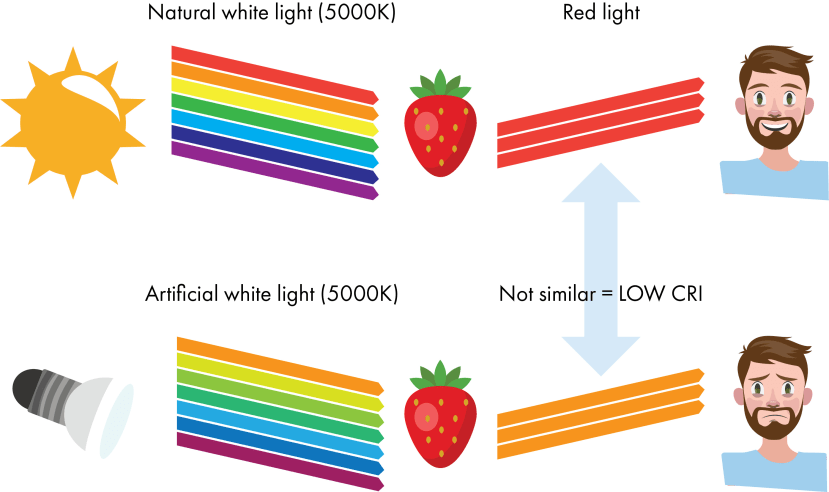Colour rendering index (CRI) is one method of measuring the distinctive attributes of a light source. It has been around since 1937 and is often misunderstood as a metric of light colour output quality. When really it is an indicator of how well an artificial typically white light source accurately renders and reproduces the colours of illuminated objects, in comparison to natural sunlight. A white LED (Light Emitting Diodes) source with a high CRI rating will render accurate and vibrant colour tones across the full spectrum.
How CRI is measured
Measured from 0-100, CRI is a convenient and easy metric to interpret as it is represented in one number. A perfect rating of 100 would mean that when under an artificial light source, an object’s colour would still appear the same as it would if under natural sunlight. Typically, any rating between 0 and 70 would be considered as poor. Whilst any ratings above 90 are considered particularly good for colour rendering.
Defining and testing for LED light source CRI rating is a more complicated process which involves specialised machinery to test the light source on multiple colour swatches (termed R1 through to R15).
How CRI is perceived
CRI cannot be perceived by simply looking at the light source alone. The quality of the CRI will only become evident when the light is viewed illuminating various objects and colours.
Although natural light appears white to the human eye, multiple colours are contained within it. The light received from the sun consists of a full spectrum of wavelengths.
When viewing an object, the colour perceived is determined by the colours of light that it reflects from the source illuminating it. So, when using artificial lighting it is important to understand how the content of the light can affect how colours subsequently are seen. Under white LED light sources, the reproduced colour of an object may appear quite similar, or quite different. Such light sources attempt to replicate the spectrum of natural daylight so that objects appear as they do under natural daylight. It is this similarity that CRI defines.

What applications require a good CRI rating?
The lighting application in question will determine how important CRI is. For many indoor lighting applications, a CRI of around 80 will be acceptable. Whereas other applications which are more dependent on light quality and colour will require a higher CRI. For example, in medical, residential, and educational applications, as well as retail stores, galleries and other photography-based applications, colour rendering is vital to provide accurate colour rendering and vibrant aesthetics. A CRI 90 or above light source will ensure colours appear as crisp and bright as they should, accurately rendered.
Even in more relaxed settings, high CRI LED lighting can still be pleasant and beneficial. Within homes, high CRI lighting can create a natural and comfortable light that enhances and highlights design detail and colour within.
Although, it is worth acknowledging that CRI is only one measurement for light quality. There are other key factors to consider such as lux and uniformity which are also accurate indicators of light quality and brightness.

